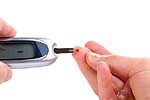Diabetes Mellitus: Symptoms and Treatment

What is Diabetes Mellitus?
Diabetes is a life-long disease marked by high levels of sugar in the blood. It is a condition in which the body cannot properly use sugar and starches from the diet, because the pancreas is not producing enough of the hormone insulin.
To understand diabetes it is important to first understand the normal process of food metabolism. Several things happen when food is digested:
- A sugar called glucose enters the bloodstream and is produced by the liver from the food you eat. This sugar is the fuel for your body.
- In a healthy person, the blood glucose level is regulated by several hormones, one of which is insulin. Insulin is produced by the pancreas, a small organ near the stomach that also secretes important enzymes that help in the digestion of food.
- The role of insulin is to move glucose from the bloodstream into muscle, fat, and liver cells, where it can be used as fuel.
- In people with diabetes the glucose in the blood cannot move into cells, and it stays in the blood. This not only harms the cells that need the glucose for fuel, but also harms certain organs and tissues exposed to the high glucose levels.
There are three major types of diabetes:
- Type 1 diabetes is typically recognized in childhood or adolescence. It used to be known as juvenile-onset diabetes or insulin-dependent diabetes mellitus. In the young diabetic there is very little insulin produced in the body and it has to be replaced by insulin injections.
- Type 2 diabetes is far more common than type 1 and makes up most of all cases of diabetes. It usually occurs in adulthood. The pancreas does not make enough insulin to keep blood glucose levels normal, often because the body does not respond well to the insulin. Many people with type 2 diabetes do not know they have it, although it is a serious condition.
- Gestational diabetes is high blood glucose that develops at any time during pregnancy in a person who does not have diabetes.
Symptoms
Diabetes is often a surprise to the individual; it can live within you and you don't even know it. Because there are no aches or pains associated with diabetes in the beginning stages, it can cause damage as it exists whether you know about it or not.
- Excessive urination: The early symptoms of untreated diabetes are related to elevated blood sugar levels, and loss of glucose in the urine. High amounts of glucose in the urine can cause increased urine output and lead to dehydration.
- Excessive thirst: Dehydration causes increased thirst and water consumption. Because of the high blood sugar levels the body tries to counteract by sending a signal to the brain to dilute the blood, which translates into thirst. The body encourages more water consumption to dilute the high blood sugar back to normal levels and to compensate for the water lost by excessive urination.
- Fatigue: In diabetes the body is inefficient and sometimes unable to use glucose for fuel. The body switches over to metabolizing fat, partially or completely, as a fuel source. This process requires the body to use more energy. The end result is feeling fatigued or constantly tired.
- Unexplained weight loss: The inability of insulin to perform normally has effects on protein, fat and carbohydrate metabolism. Insulin is an anabolic hormone, that is, one that encourages storage of fat and protein. A relative or absolute insulin deficiency eventually leads to weight loss despite an increase in appetite.
- Poor wound healing: High blood sugar levels prevent white blood cells — which are important in defending the body against bacteria and also in cleaning up dead tissue and cells — from functioning normally. When these cells do not function properly, wounds take much longer to heal and become infected more frequently.
- Blurry vision: Blurry vision is not specific for diabetes but is frequently present with high blood sugar levels.
- Some untreated diabetes patients also complain of nausea and vomiting. Patients with diabetes are prone to developing infections of the bladder, skin, and vaginal areas. Extremely elevated glucose levels can lead to lethargy and coma.
Treatment
There are three main forms of treatment:
- Diet to reduce the amount of sugar containing food in the diet, such as bread, cake, biscuits, sweets, sugar and potatoes so that the body can cope better with lessened demands.
- Tablets may help the 'mature' diabetes.
- Insulin injections may be given to replace the insulin that is missing in the patient who has diabetes.
|